



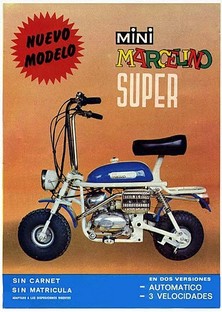
Mini Marcelino Super Advertisement
In the late 1960s in Spain, it was not easy for a Spanish family with an average purchasing power to buy a Ducati Mini Marcellino at the price of 13,060 pesetas (€78.49), when a Seat 600 cost 68,100 pesetas (€409.29). Despite Spain's economic progress, this motorcycle was a whim only within the reach of a few, so many children had to wait for this expensive "toy" and continue to spend time with other more popular games such as spinning tops, marbles or Geyper Games, "All in one".
These were years of dreams that could be achieved, the awakening of a society that believed again and again that with effort almost everything could be achieved, the very boom in Europe for mini bikes for adults with
many brands in the race (Honda, Di BLasi, Moto Graziella, Beta, Fantic, etc.) propelled the idea of the first mini bike manufactured
entirely in Spain.
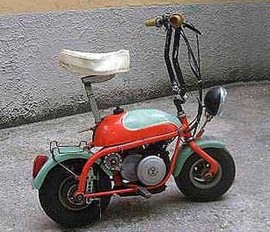
Mini Marcellino Italian First Series original
In these years of prosperity, in the Levantinos workshops of Dismave S.L. (Industrial Design of Sagunto and Machinery of
Vehicles), in Sagunto (Valencia), seeing the potential that mini bikes had, the idea of "remanufacturing" a model of "folding mini bike" already existing in
Italy was brewing, they opted for a license of the Italian model instead of creating their own, surely they were right considering the problems that Sanglas later had with his "Folding 50".
Dismave bought the license and production rights for a model marketed and manufactured in Italy between 1967-1969 by the manufacturer DINAMICA MECCANICA TASSINARI (D.M.T.) in the city of Ravenna, always incorporating 47.6 cc Franco Morini engines. The S5.k and F5.k models, the first model was presented at the Milan Motorcycle Show in 1967, with the unmistakable name of Mini Marcellino.
Sanglas con su "Plegable 50".
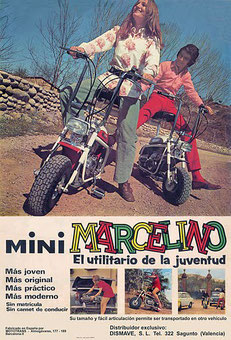
Original vintage advertisement
The Mini Marcellino moped, in its first models, had a small 47.6 cc engine attached to a simple rigid frame without rear suspension and with inverted front suspension by short connecting rods, mounted three-inch wheels and as an extra it could carry shoulder bags in its small rear carrier, a tool box and few other details of a normal moped, as shown in this period advertisement.
The invention started in its beginnings with an automatic engine with a "wind-up" start on its left side, similar to the start of a lawnmower, later it mounted engines with a start through a lever located on the right side of the engine.
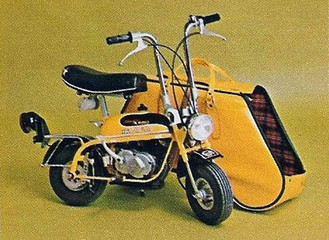
Mini Marcellino Segunda Serie modelo "Super América" con bolsa de transporte
Its small size was ideal for carrying it in a transport bag made specifically for it, with only the saddle and tool box sticking out. The bag was made of rain-resistant synthetic leather on the outside with a plaid interior lining.
So many quality details quickly made it the charming motorcycle to enjoy on vacation, to travel through sea and fishing ports, and even widely used by truck drivers in loading and unloading areas, advertising itself as “Small, resistant and practical” (Piccolo, robust and practical).
As with the Spanish Mini Marcelino model, the Italian model had at least two distinguishable versions, both with the same rigid frame, although the second model incorporated inverted telescopic front suspension, and independent speedometer among other small aesthetic changes. These changes led to the choice of a "Normal" model and another called "Super America", with more standard equipment.
-->
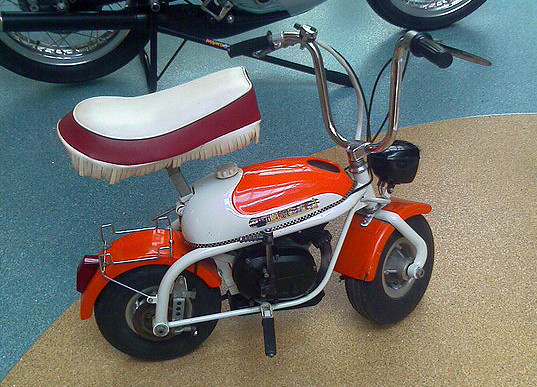
Mini Marcellino Italian First Series but with Malaguti engine, not original from the factory
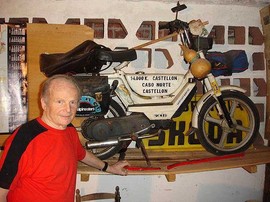
Ernesto Palmieri and his famous Vespino Vale, with which he covered 14,000 km. in Cabo Norte
In 1968, Dismave hired Ernesto Palmieri Pirazzoli, a former Ducati rider and mechanic, born in Bologna (Italy), whose job was twofold: obtaining a license and adapting the model to the local availability of components, from ordering the manufacture of tires that did not exist here, to adapting an engine, everything except importing. That same year, Palmieri returned from Italy with the license for the Mini Marcellino moped.
Ernesto was without a doubt the "Father" and creator of the mini project in Spain, well acquainted with the Ducati brand and its reliable performance and with hardly any direct rivals (Torrot, Rieju), he encouraged the choice of these small Ducati Mototrans engines for its first launch.
In times of scarce economic financing, Ernesto joined forces with two investors, one provided the necessary capital and the other his workshop in Sagunto (Dismave). Ernesto took charge of the project taking the reins of the production rights with Dismave, commissioning Ducati to exclusively build the engine model, through its Catalan subsidiary, Mototrans.

Announcement of Mototrans with Ducati Meccanica license in 1969
That is why there is controversy over whether the Mini Marcelino Española is a Ducati model or not, since it was always advertised in magazines and publications apart from Ducati advertising, but what we cannot deny is that it has always been fitted with the engine manufactured by Ducati Mototrans España. For example, no one denies that the Montesa Ciclo 50 model is not from Montesa because it had a JLO engine in its early days.
Although I do not doubt that the first units were manufactured in Sagunto by Dismave, however, in the first publications and advertising
it appears; “Manufactured by Mototrans”, the proof of its origin, without a
doubt, is that all the Certificates of these motorcycles that we have verified are issued by the Delegation of Industry of Barcelona.
From 1970 the "Mini Marcellinos commercial" were manufactured by Dismave and Mototrans, although Dismave took care of the
distribution and after-sales.
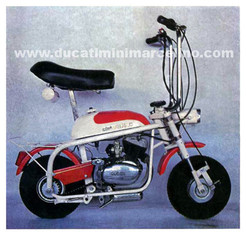
First Spanish Mini Marcellino
In this way, in 1969, the first model of the Spanish Mini Marcellino (name with double “L”, like the Italian one) with a rigid chassis was born, which rolled out of the factory presenting a revolutionary and surprising system of disc brakes (only used by Lambretta in its last model and evidently in Mini Marcellino Italiano).
The first models with a fibre tank were started with a quarter turn of the pedal, they had a low production, quickly moving on to the commercial models in basic colours (blue, red and yellow with white) and gradually becoming aesthetically disassociated from their Italian predecessor.
Note: The Ducati engine that Mototrans manufactured for the Spanish Mini Marcelino was NEVER started "by winding", as it was in the first units of the Italian model with a Franco Morini engine. I have read nonsense on other blogs and I don't understand why people make up things that are not true. The Ducati engine that Mototrans manufactured was always started by a quarter turn of the pedals and anyone who says otherwise does not know these engines.
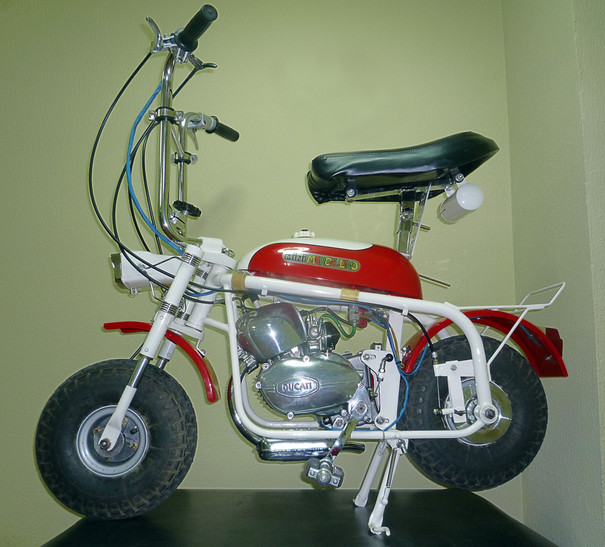
Ducati Mini Marcellino Primera Commercial series restored
The Mini Marcelino was a mini motorbike model never seen before in Spain, expertly designed to solve traffic problems and frequent displacements in the city.
Until 1971, the model was maintained with minor modifications to its functional design. Models with automatic transmission and another with a three-speed manual transmission on the handlebar appeared, a model that was even more sought after due to its small production, since it was the buyer's choice and required a little more driving skill.
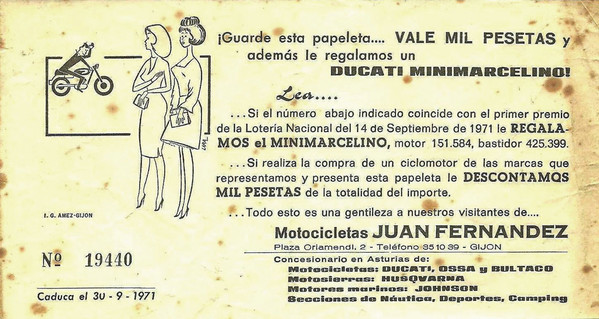
Original paper drawing of a Mini Marcelino in 1971, in Gijón
In those wonderful years the Mini Marcelino was the undisputed queen as the first prize in any raffle or competition, even raffled in nightclubs on weekends, an object coveted by any child as it could be driven without a license or registration, nor did it have to pass the tedious MOT of today, the legality was to have the obligatory but essential pedals to start it and to use it as a bicycle in any case.
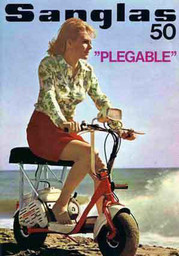
Sanglas Plegable 50 (Foldable 50)
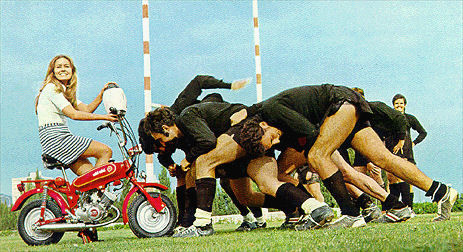
Vintage advertising for the Montesa Mini Mini
Spain, with a limited production of its own models of mini motorbikes, relegated to a few brands that made their "mini" debuts, such as Montesa (Montesa Mini Mini, very sought after as only 125 examples were made), or the Cota 25, Bultaco ( Tirón y Chispa), Sanglas (with the "Plegable 50", of 4 brands), not much success and practically no attempt to market it by moving to the prototype category, or its own Ducati through Mototrans, on its branch in Spain, manufacturing two more models, including the Mini Marcellino models, not so many “minis”, such as the Ducati Mini 2 and the Ducati Mini 3.
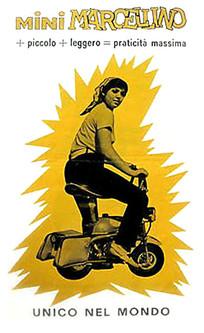
Original advertising from the period
The obvious progression from the first model was the new Mini Marcelino Super model (the name is Spanish-ized by losing the double "L"), presented at the 1971 Barcelona International Motor Show, where the new frame with rear suspension stands out above all, which is appreciated by the users' backsides, the tank completely loses its lines of relief design and aesthetics from its origins, becoming smooth and with a little more capacity, the headlight becomes round and larger, the first one was rectangular.
The seat is cut and rounded, it stops carrying the tool box in its lower part to move to the right side of the frame, next to the rear shock absorber, the luggage rack becomes an integral part of the frame, now being more rigid and robust, with anchorage for a supposed extra spare wheel.
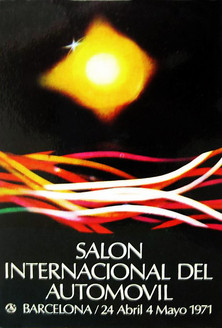
Poster for the 1971 Barcelona International Motor Show
The exhaust rises to the left side, is no longer located under the engine and is covered with a grill to protect against possible burns, is embellished with a beautiful and shiny chrome, and also has a screw at the bottom to bleed off any unburned oil residue during combustion.
The old engine provided 1.8 HP, which is now more powerful, it is still the same engine but increases to 2.2 HP thanks to the new Dell´Orto SHA 14/14 carburettor that replaces the previous Dell´Orto SHA 14/12.
The Super model weighed two kilos more than the rigid chassis one, even so, the weight of this machine does not exceed 30 Kg.
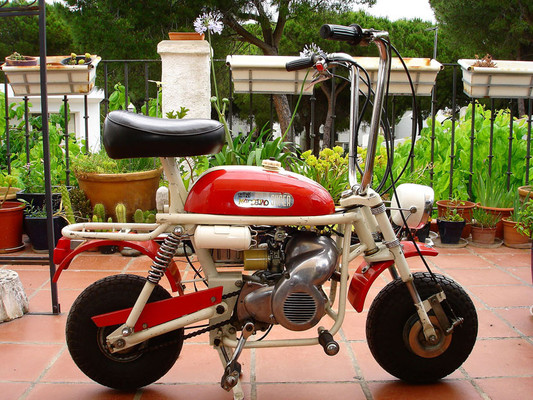
Mini Marcelino Super in original condition, a white blackbird after 40 years!
The success of the Mini Marcelino models only lasted until 1973 from their beginnings in 1969, probably due to their high sales price, a real indulgence in those years compared to other more versatile and practical models also manufactured by Ducati through Mototrans.

Riding Mini Marcelino on a Merry-Go-Round
The tiny Mini Marcelino fell into oblivion and was gradually relegated to showing themselves timidly in the "charlotadas", ridden by their incredible "Bombero Torero y sus Enanitos Toreros", or in small carousels at traveling fairs in towns and cities, the famous "children's rides", making the "static delights" of the little ones and the astonished admiration of their parents, who saw them running through the streets in the seventies...
Fortunately, there are still enough examples and enough nostalgic mini bikers to revive these unforgettable and fun motorcycles. Rescuing them from scrapyards and reviving them gives great personal satisfaction.
As a result of the power of these small engines, several types of single-seater fiberglass karts were manufactured, all with a Ducati Mini Marcelino engine. These karts with different types of models (Pony, Formula and Sport) were manufactured by Miguel Tapias Karts (MTK), founder of the prestigious Arisco brand, from Tarrasa (Barcelona), in the early seventies.
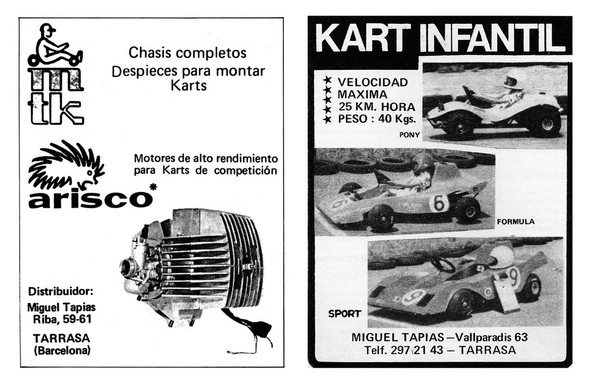
Arisco racing engines and karts advertisement
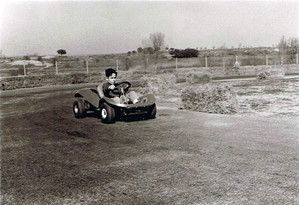
Pony go-kart
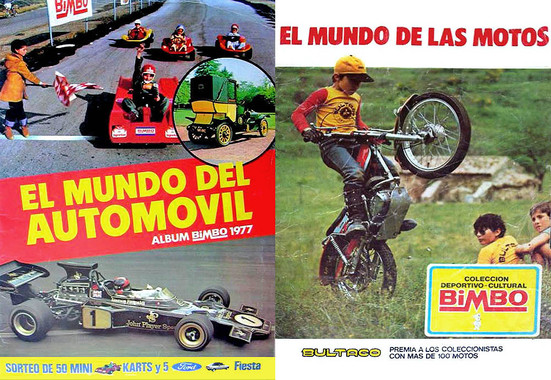
Back and front cover of the album "El mundo de las motos" by Bimbo

Kart Family
The small and noisy MTK Karts became very popular among kids thanks to the Bimbo product sticker album, "The world of motorcycles" from 1976, where they raffled them off if you finished the whole album, not to mention the "Bucaneros" and "La Pantera Rosa" that you had to eat, although they were so delicious that at that age it was a pure pleasure!.
The "El mundo de las motos" album from Bimbo from 1976 is very sought after today, reaching a high price if it is complete and in good condition, an album that I highly recommend to all lovers of classic motorcycles.
The MTK Karts did not reach the top speed of 40 km/h, like our little Mini Marcelinos, but 25 km/h was enough to make us believe ourselves the kings of the asphalt and emulate Emerson Fittipaldi, who devoured the Formula 1 trophies in those glorious years... you had to be careful when taking the very tight curves because they easily went to two wheels.
These Karts were used a lot in educational tests for children on road traffic promoted by the general direction of traffic at the time.
I did not get the Kart after completing the blessed album but apparently our Royal Family did... "Royal Luck"!

Kart MTK - Ducati 48, "Formula" models restored in detail
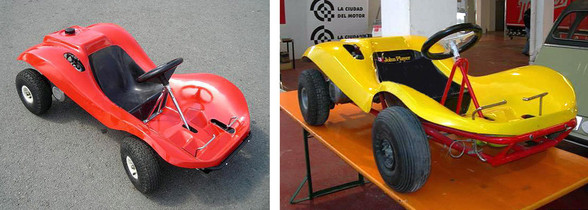
Kart MTK - Ducati 48, "Pony" models in perfect condition

Narbino two-seater kart
Almost at the same time, another type of Kart was manufactured with the same engine as the Mini Marcelino, much larger and more robust, but with two seats, manufactured by Narbino, with a slightly more buggy aesthetic and more "country" features, as can be seen in the photograph on the right.
As a curious anecdote, the same Ducati engine was used by other brands such as Ossa or Bultaco. The Bultaco Tirón trial model was created for children, although it had become outdated and was too heavy for children. Therefore, in 1974, the Bultaco Chispa was launched. It was lighter and more comfortable and replaced the Tirón, which ceased production. They had to get their act together because the Montesa Cota 25 was having great market success and Bultaco did not want to be left behind.
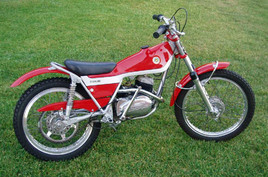
Bultaco Chispa 1974
The Chispa was a miniature replica of the Sherpa "Kit" 124 and 125, really nice, light and very suitable for trials by children from four years old. Everything was made to measure for children, except the levers, just like on the big bikes.
It was equipped with a 47.6 cc Ducati engine with three gears that remained in production from 1974 until the factory closed in the early 1980s. Its Ducati engine adapted for trials was a copy of the Sherpa T but on a child's scale, an authentic mini-trial bike.
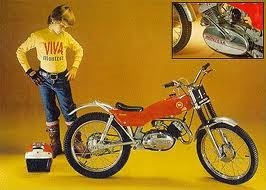
Montesa Cota 25
The Chispa developed 2 hp with a Dell'Orto 14/12 carburettor, 2.00/16 front wheels and 2.5/15 rear wheels. It was a pleasure to drive, the power it developed and the great difference it had over its arch enemy, the famous Montesa Cota 25, the only drawback was the exhaust pipe that went up too far on the right side and you got burned at the first change.
As we can see in the following photograph, the size of the Bultaco Chispa was really small compared to our Mini Marcelino First Series...
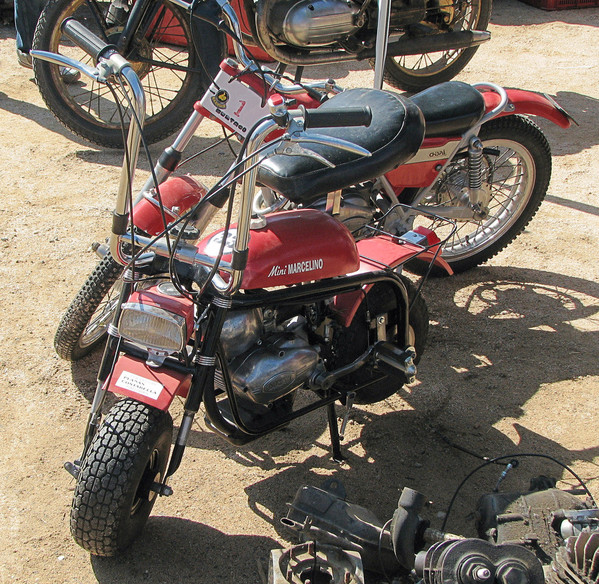
Comparative sizes of Mini Marcelino and Bultaco Chispa. Photo by Josep María Galindo
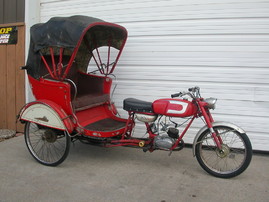
I also give you this example that I found of a Ducati Falcon 50 (it would correspond to our Ducati 48 TS) pulling a pitiful "Rickshaw" typical in India, a "mototaxi" with capacity for two people plus the driver, its engine is almost identical to that of a Mini Marcelino, I think the image speaks for itself of the driving force of the small Ducati engines.
The latest research into the versatility of the Mini Marcelino engine in the 70s led him to adapt his small engine to a tricycle as a "cart for the disabled."
In telephone conversations with the son of the owner of the Dismave workshops in Sagunto, we were able to learn that a third model of the Mini Marcelino was in the works, after the Super model, with greater technical features and a slightly larger and more robust frame, which was ultimately not built and remained in the prototype phase. Without a doubt, it was a real shame that it did not come to light for the enjoyment of minibikers...
Adapted from an archive of ducatiminimarcelino.com at web.archive.org ~ Licence: CC BY-SA 3.0
If you have a query or information about these motorcycles please contact us